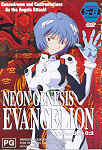Neon Genesis Evangelion-Collection 0:2 (Episodes 5-8) (1997) |
|
Neon Genesis Evangelion-Collection 0:2 (Episodes 5-8) (1997) |
|


|
| BUY IT |
| General | Extras | ||
| Category | Anime |
Biographies-Character Trailer-3 DVD Credits |
|
| Rating |

|
||
| Year Of Production | 1997 | ||
| Running Time | 94:18 (Case: 120) | ||
| RSDL / Flipper | No/No | Cast & Crew | |
| Start Up | Menu | ||
| Region Coding | 1,2,3,4,5,6 | Directed By | Hideaki Anno |
|
Studio
Distributor |
 Madman Entertainment |
Starring | None Given |
| Case | Amaray-Transparent | ||
| RPI | $29.95 | Music | Shiroh Sagisu |
| Video | Audio | ||
| Pan & Scan/Full Frame | Full Frame |
English Dolby Digital 2.0 (192Kb/s) Japanese Dolby Digital 2.0 (192Kb/s) |
|
| Widescreen Aspect Ratio | None | ||
| 16x9 Enhancement | No | ||
| Video Format | 576i (PAL) | ||
| Original Aspect Ratio | 1.33:1 | Miscellaneous | |
| Jacket Pictures | No | ||
| Subtitles | English | Smoking | No |
| Annoying Product Placement | No | ||
| Action In or After Credits | Yes, after credits | ||
The transfer is presented in an aspect ratio of 1.33:1 and is not 16x9 enhanced.
Sharpness is very good most of the time, but there are several scenes that are rather soft. The two most noticeable examples of this are at 56:17 and 78:43. There are many occasions where the black lines that make up an object are sharp in one spot but blurry in another. In some instances, it almost looks like water has fallen onto the artwork and caused the black line to run slightly, such as at 6:10, 10:15, 16:03 and 59:14. A slightly more annoying and distracting variation of this problem is where a black line or lines on a still object go in and out of focus. Thankfully, I only saw two minor instances of this in this transfer, at 28:30 and 54:02.
There isn't much in the way of shadow detail. In fact, there is basically none, but I guess this is to be expected since this is a cartoon.
Two trivial instances of vertical banding were noticed, at 2:15 and 91:02 See my X-Files Season 1 Box Set review for a picture and further details of this artefact. No low-level noise or edge bleeding was noticed, with only one minor instance of edge enhancement being noticed at 26:31. There was a more unusual artefact at 6:57, which looked like an NTSC-to-PAL conversion artefact, but I felt it was caused by something else. It is pretty minor, and is a one-off.
There are several scenes that suffer from some minor interlacing artefacts. Thankfully, these are not too disruptive to the picture. Some examples are at 40:48, 56:05, 73:49 and 73:56.
The colour was good and true to the original content, with all objects being well-saturated.
Only one trivial instance of grain was noticed, at 41:37, which looked like it was inherent in the master material. No pixelization was noticed - this is another area that has been improved upon from the first disc.
No MPEG artefacts were noticed. No instances of aliasing or moiré artefacts were noticed, but there was one instance where a black line appeared jagged for a couple of frames and then become much sharper and smoother, at 18:10, but this was minor. Telecine wobble is a more concerning problem for this transfer. There appears to be a trivial amount present from the opening frame to the closing frame. For much of the time it is not distracting or even noticeable, but there are too many instances where it does become quite noticeable and distracting, even on my TV. Some of the more noticeable instances are at 9:18, 46:49, 62:37, 69:03 and 78:01. The End Credits still have their jitter and focus problems, but it is not quite as bad as on the first disc.
The most noticeable film artefacts were in the form of damage to the top or the bottom of the frame. This damage usually only lasted for one or two frames and was confined to the top or bottom 10 lines of the picture, so it doesn't interfere with the main picture. If you are watching on a TV set, then you probably won't even see this damage because these lines are usually hidden by overscan. Examples of this damage are at 5:46, 7:15, 30:06 and 57:48. Not one of these were noticeable on my 68cm TV. At 57:48, the damage to the master material was a little more serious, with several creases visible in the image, but you will have to pause the picture at this point to be able to see them as they only appear for one frame.
| Sharpness | |
| Shadow Detail | |
| Colour | |
| Grain/Pixelization | |
| Film-To-Video Artefacts | |
| Film Artefacts | |
| Overall |
The dialogue was clear and easy to understand throughout the entire movie.
The original series was made for Japan, with Japanese dialogue, so the dubbed English dialogue is naturally way out of sync.
The music score is by Shiroh Sagisu.
The surround channels were nicely used for music and the odd sound effect.
The subwoofer is lightly used throughout the episodes, mostly for the music.
| Dialogue | |
| Audio Sync | |
| Clicks/Pops/Dropouts | |
| Surround Channel Use | |
| Subwoofer | |
| Overall |
The main menu is presented in an aspect ratio of 1.33:1 and has audio and video animation. In fact, all menus have audio and video animation, which certainly enhances the menus. There is also some additional animation when you select menu items. Did I mention the great cover artwork?
NOTE: To view non-R4 releases, your equipment needs to be multi-zone compatible and usually also NTSC compatible.
The overall picture quality is pretty reasonable, but it does have its problems. On a projector its weaknesses are often quite noticeable and become rather distracting on many occasions. On my 68cm TV set however, the picture looked great.
There are no transfer-induced faults in the audio, so there is little to nothing to complain about in this regard.
Extras are limited.
| Video | |
| Audio | |
| Extras | |
| Plot | |
| Overall |
| Review Equipment | |
| DVD | Sony DVP-725, using Component output |
| Display | Sony Projector VPH-G70 (No Line Doubler), Technics Da-Lite matt screen with gain of 1.0 (229cm). Calibrated with Video Essentials. This display device is 16x9 capable. |
| Audio Decoder | Built in to amplifier/receiver. Calibrated with Video Essentials. |
| Amplification | Onkyo TX-SV919THX |
| Speakers | Fronts: Energy RVS-1 (3), Rears: Energy RVSS-1 (2), Subwoofer: Energy EPS-150 (1) |